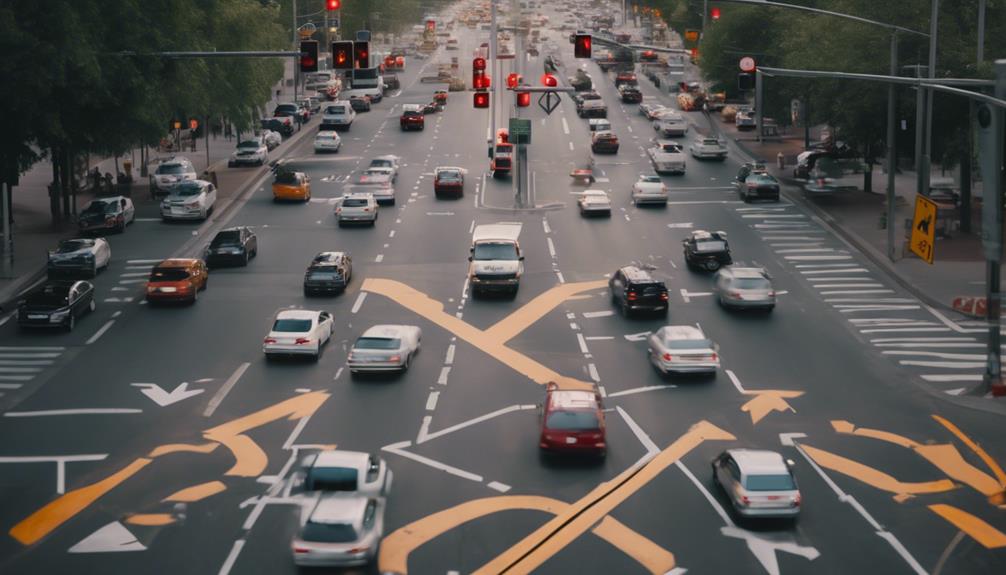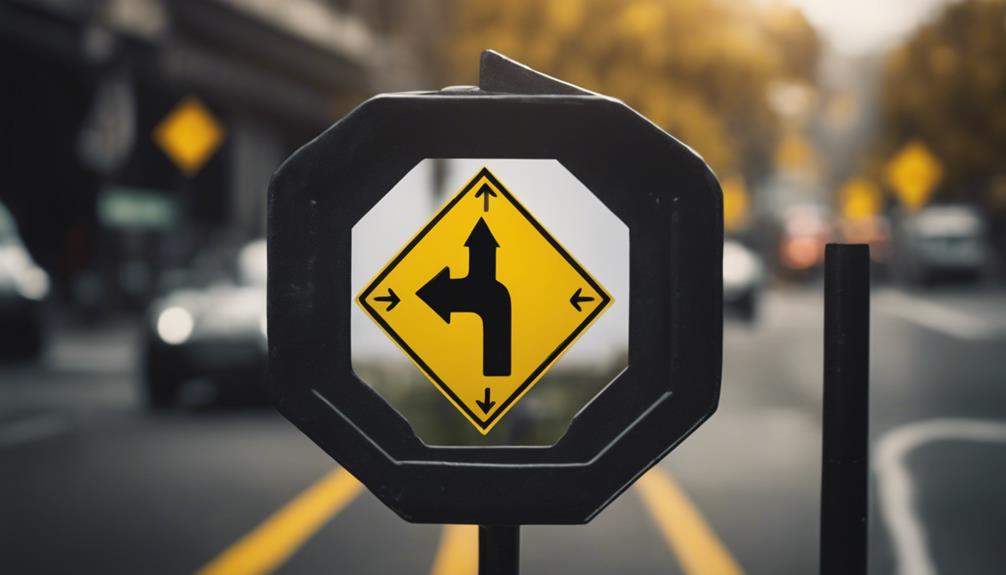Road signs are essential for guiding us on the road. The height of road signs is vital for visibility. For street name signs, 6-inch lettering is optimal. On local roads with speed limits under 30 mph, opt for 4-inch lettering. Use white lettering on a green background for clarity. Street name signs on local roads should be at least 4 inches high. Consistency in font helps readability. Different letter heights based on speed limits aid quick identification. To enhance legibility, use contrasting colors. Remember, adherence to height guidelines ensures clear and effective communication on the road.
Key Takeaways
- Sign heights vary based on location and purpose.
- No maximum height specified in MUTCD regulations.
- Minimum height for pedestrian signs is 7 feet.
- Signs over traffic lanes should be 17 feet high.
- Proper installation prevents stacking and ensures readability.
Importance of Sign Visibility
Ensuring road signs are positioned at the proper height is essential for drivers to quickly and safely respond to important information while on the road. Properly placed signs, including various signs like speed limits, stop signs, and directional markers, play a pivotal role in guiding drivers effectively.
When road signs are at the correct height, they enhance visibility, enabling drivers to read and comprehend the information without distraction. This is especially important during adverse weather conditions or low-light situations, where clear and visible signs can make all the difference in preventing accidents.
Additionally, maintaining consistent sign height standards for road signs contributes to the overall safety and efficiency of traffic flow. By adhering to these standards, drivers can anticipate and react to upcoming road conditions promptly, ultimately enhancing road safety for all road users.
Proper sign visibility isn't just a matter of convenience; it's a fundamental aspect of road safety that can't be overlooked.
Minimum Lettering Size Guidelines

When contemplating road sign lettering size, it's essential to grasp the impact it has on legibility from a distance. Larger lettering enhances visibility, particularly in low-light conditions or when drivers need to swiftly identify street names.
Lettering Legibility Distance
To guarantee excellent legibility, street name signs should feature lettering heights of at least 6 inches. When considering the best lettering size for street signs, it's crucial to take into consideration the speed limits of the road.
For local roads with speed limits of 30 mph or less, a minimum of 4-inch lettering height is acceptable. Street name signs commonly display white lettering on a green background, ensuring clear visibility for drivers. Additionally, alternative color combinations such as white on blue or brown, or black on white, are also permitted for street name signs.
Supplementary lettering indicating street type or direction can be reduced to 3 inches in height to maintain effective communication.
Impact of Size
Properly sized lettering on street name signs is essential for maximizing visibility and ensuring safe driving for drivers. According to guidelines, the minimum lettering height for street name signs should be at least six inches to optimize readability. However, signs on local roads with speed limits of 30 mph or less can have slightly smaller lettering at four inches.
These standardized size regulations were established in 2009 with the adoption of the National MUTCD. Additionally, supplementary lettering indicating street type or direction can be reduced to three inches in height.
It's important to maintain proper lettering size and ensure sufficient contrast with background colors to enhance sign legibility and recognition, ultimately aiding drivers in safely and efficiently using the roads.
Sign Lettering for Local Roads
When creating street name signs for local roads, it's important to prioritize clear visibility for drivers.
Ensuring consistency in font and choosing an adequate size for readability are key points to remember.
Clear Visibility for Drivers
Ensuring clear visibility for drivers on local roads, street name signs with lettering should be at least four inches in height for speed limits of 30 mph or less. To assist drivers effectively, the first letter on these signs must be in upper-case, followed by a mix of upper and lower-case letters.
For optimum visibility, consider using white lettering on a green background for street name signs. When including supplementary lettering for directional indicators, it's acceptable to reduce the height to three inches.
Consistency in Font
To guarantee maximum legibility and consistency in font on street name signs for local roads, it's imperative to follow the guidelines outlined in the 2009 National MUTCD.
For local roads with speed limits of 30 mph or less, street name signs should have lettering heights of at least four inches. The lettering should be a mix of upper and lower-case letters, with the first letter in upper-case for better readability.
Typically, street name signs for local roads feature a white legend on a green background to ensure excellent visibility. Acceptable color combinations also include white on blue or brown, as well as black on white.
Adequate Size for Readability
Maintaining appropriate lettering size is crucial for guaranteeing the readability of street name signs on local roads with speed limits of 30 mph or less. When considering the size of the lettering on street signs, the following points should be taken into account:
- Lettering height for street name signs on local roads should be at least four inches to enhance visibility.
- The first letter in the street name sign legend should be in upper-case, followed by a mix of upper and lower-case letters for clarity.
- Street name signs on local roads commonly feature white lettering on a green background to maximize visibility.
- Supplementary lettering indicating street type or direction can be reduced to three inches in height for improved readability.
Adhering to the guidelines outlined in the Standard Highway Signs and Markings (SHS) Book ensures that street name signs on local roads are appropriately sized for top-notch visibility.
Impact of Speed Limits

Influenced by the speed at which vehicles travel, the height of street name signs' lettering plays an important role in ensuring quick identification and safe navigation. On local roads where speed limits are 30 mph or less, the lettering on street name signs should be a minimum of four inches high. This size allows drivers to easily spot and read the signs, aiding in timely street recognition. As the speed limit increases on major roads, such as highways where vehicles often travel at higher speeds, the lettering should be even larger to accommodate the reduced reaction time. Maintaining clear and visible street signs is crucial for public safety and efficient traffic flow, and municipalities take this seriously, sometimes imposing fines or even jail time for stealing road signs. Theft of road signs can cause confusion, delayed emergency response, and accidents, making it a serious offense that carries significant penalties.
Conversely, roads with higher speed limits necessitate larger lettering, typically at least six inches in height. These larger letters are essential for visibility at greater speeds, enabling drivers to quickly locate and process street names while maintaining safe driving practices. Adhering to the specified lettering sizes based on speed limits ensures that street name signs effectively fulfill their purpose of providing clear and readable information to drivers.
Enhancing Legibility With Colors
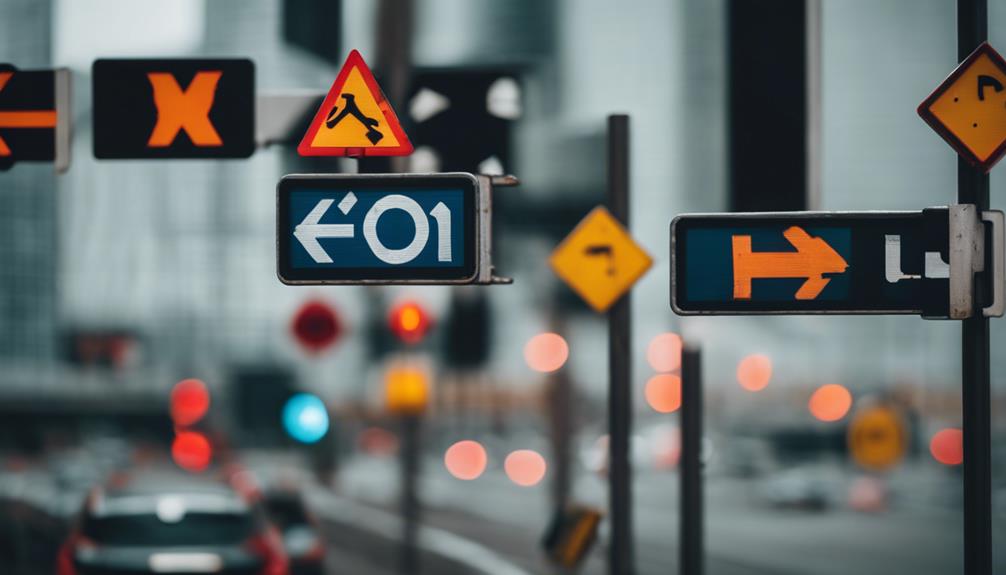
Utilizing specific color combinations on street name signs greatly enhances their legibility and aids drivers in swiftly identifying and finding their way on roads. When it comes to enhancing legibility with colors on street name signs, there are several key points to take into account:
- White on Green Background: Street name signs commonly feature a white legend on a green background, a classic combination that improves visibility for drivers.
- Alternative Color Combinations: While white on green is popular, other acceptable color combinations include white on blue or brown, as well as black on white. These combinations also assist with readability on the road.
- Contrasting Colors for Legibility: Using contrasting colors, such as white on a dark background, can greatly enhance legibility from a distance, making it easier for drivers to spot and read street names quickly.
- Regulated Color Choices: Color choices for street name signs are standardized to ensure consistency and readability for drivers, ultimately contributing to overall road safety.
Standards From SHS Book
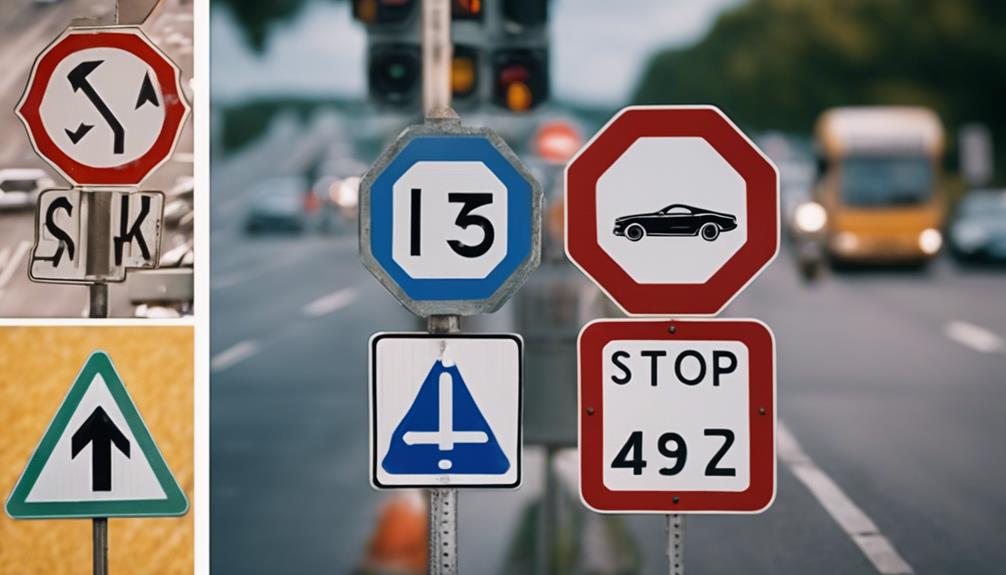
Adhering to the Standards From the SHS Book guarantees proper sizing and readability of roadway signs to assist drivers in navigation. The SHS Book specifies a 12-inch height for 6-inch letters and an 8-inch height for 4-inch letters on signs. For signs with 6-inch letters, the sign blank should be 12 inches high according to SHS guidelines.
Similarly, signs with 4-inch letters should have a sign height of 8 inches as per the SHS Book standards. Additionally, supplementary lettering size indicating street type or direction can be reduced to 3 inches based on SHS Book recommendations.
Both FHWA and NYSDOT confirm the sizing standards outlined in the SHS Book for street name signs. By following these standards diligently, road signs can be designed and placed in a manner that optimizes visibility and legibility for drivers, ultimately enhancing safety on roadways.
Compliance With MUTCD Regulations
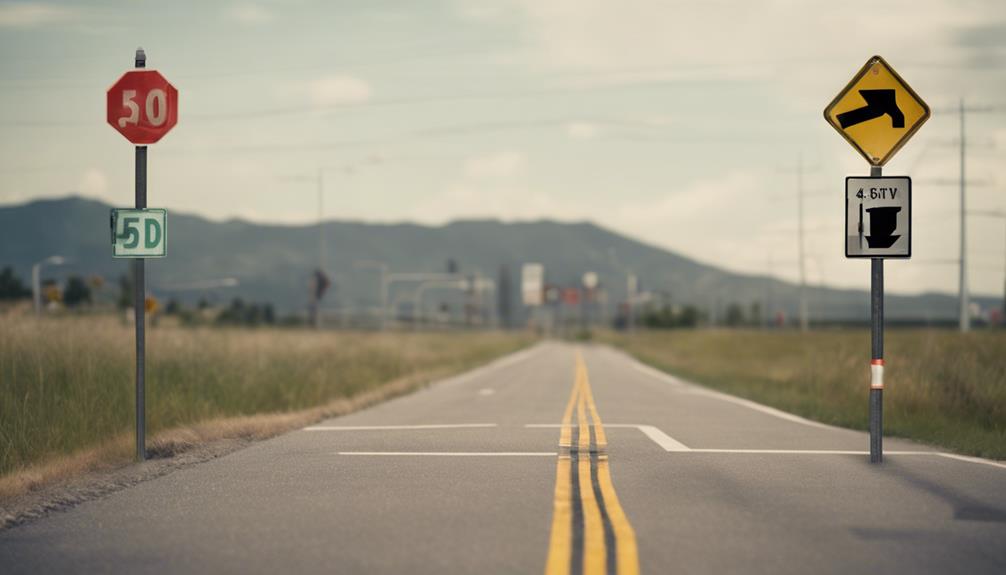
Adhering to MUTCD regulations is essential for ensuring consistency and safety in roadway sign design. When it comes to compliance with these regulations, there are key points to keep in mind:
- No Maximum Height: MUTCD regulations don't specify a maximum height for roadway signs, but they do provide guidance on minimum heights for different types of signs.
- Minimum Height for Pedestrian Signs: For pedestrian signs, the minimum height from the ground to the bottom of the sign should be 7 feet. This guarantees visibility and accessibility for pedestrians.
- Height for Signs Over Traffic Lanes: Signs located over traffic lanes should have a minimum height of 17 feet to the bottom of the sign. This elevation helps prevent obstruction and ensures clear visibility for drivers.
- Installation Considerations: Factors such as readability, graffiti prevention, and avoiding the stacking of signs should also be taken into account when installing roadway signs. Following these guidelines is essential for maintaining compliance and uniformity in street name sign design.
Frequently Asked Questions
How High Should a Road Sign Be?
When determining the height of a road sign, it's important to take into account various factors for safety and visibility.
Road signs over traffic lanes need to be at least 17 feet tall to guarantee proper clearance.
For pedestrian signs, a minimum height of 7 feet from the ground is recommended.
These guidelines help optimize readability, prevent graffiti, and maintain visibility.
Following installation instructions is key to making sure that road signs are positioned appropriately for effectiveness.
What Is the Height of a Mandatory Sign?
The height of a mandatory sign should typically be 7 feet from the ground to the bottom of the sign for visibility to pedestrians. This height guarantees clear readability and compliance with traffic control regulations.
It's essential to place signs at appropriate heights to prevent graffiti, adhere to guidelines, and enhance road safety. Proper sign height considerations also aim to avoid stacking signs, optimize visibility, and maintain an effective traffic signage system.
What Is the Typical Size of a Road Sign?
Road signs typically have specific sizes to guarantee visibility and quick recognition. The main legends are usually 6 inches tall, while supplementary information is 3 inches high. Sign blanks for 6-inch lettering are 12 inches tall, and for 4-inch lettering, they're 8 inches high.
Following the Standard Highway Signs and Markings Book's guidelines is crucial for proper sizing and color combinations, promoting uniformity and safety on the roads.
What Is the Correct Height of a Stop Sign?
The proper height of a stop sign should be at least 7 feet from the ground for visibility to pedestrians and 17 feet over traffic lanes. Correct height placement guarantees readability and clear visibility for drivers and pedestrians, preventing issues like graffiti and ensuring effective traffic control.
Adhering to recommended standards maintains consistency and uniformity in traffic sign placement for safer road conditions.
Conclusion
To sum up, the height of road signs plays a vital role in ensuring safety and efficiency on our roadways. By following guidelines for lettering size, considering speed limits, and utilizing legible colors, we can enhance visibility for all drivers.
Remember, adhering to standards set by organizations like SHS and complying with MUTCD regulations are essential for creating a clear and informative road sign system.
So, let's aim for signs that are so tall they reach the sky!





